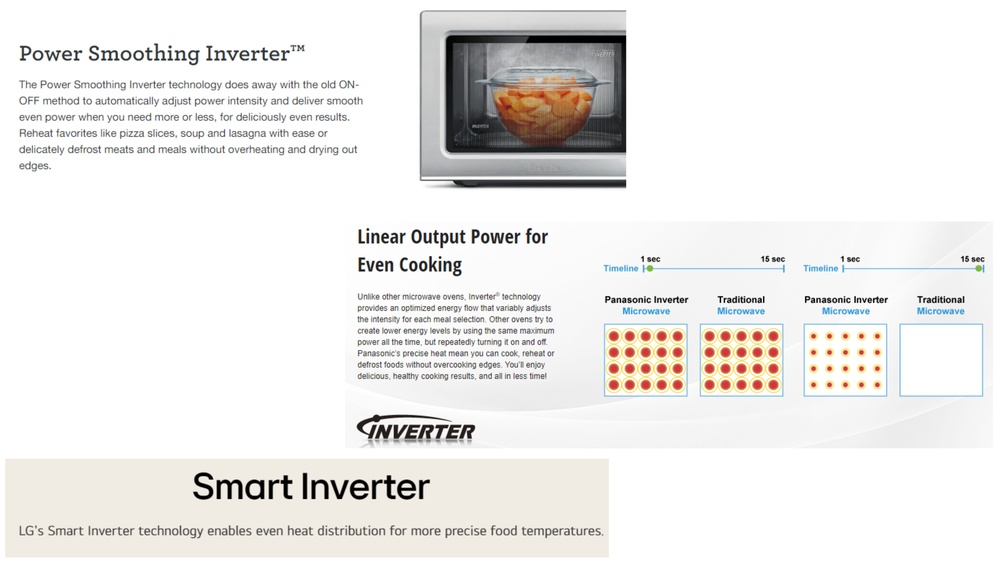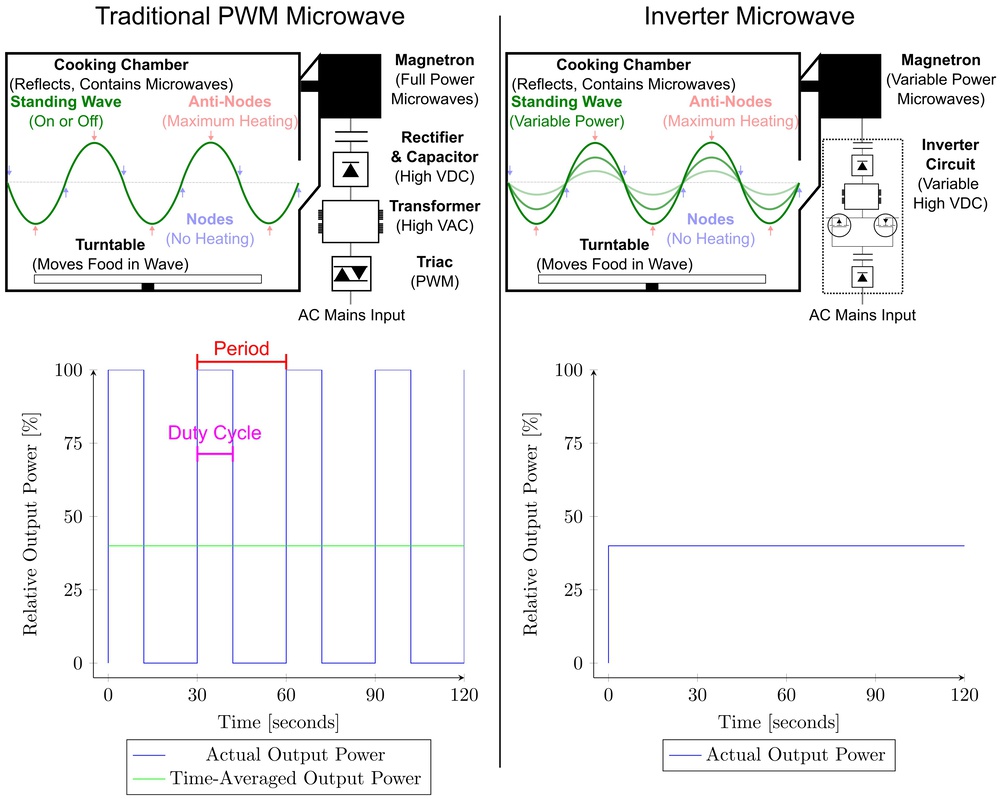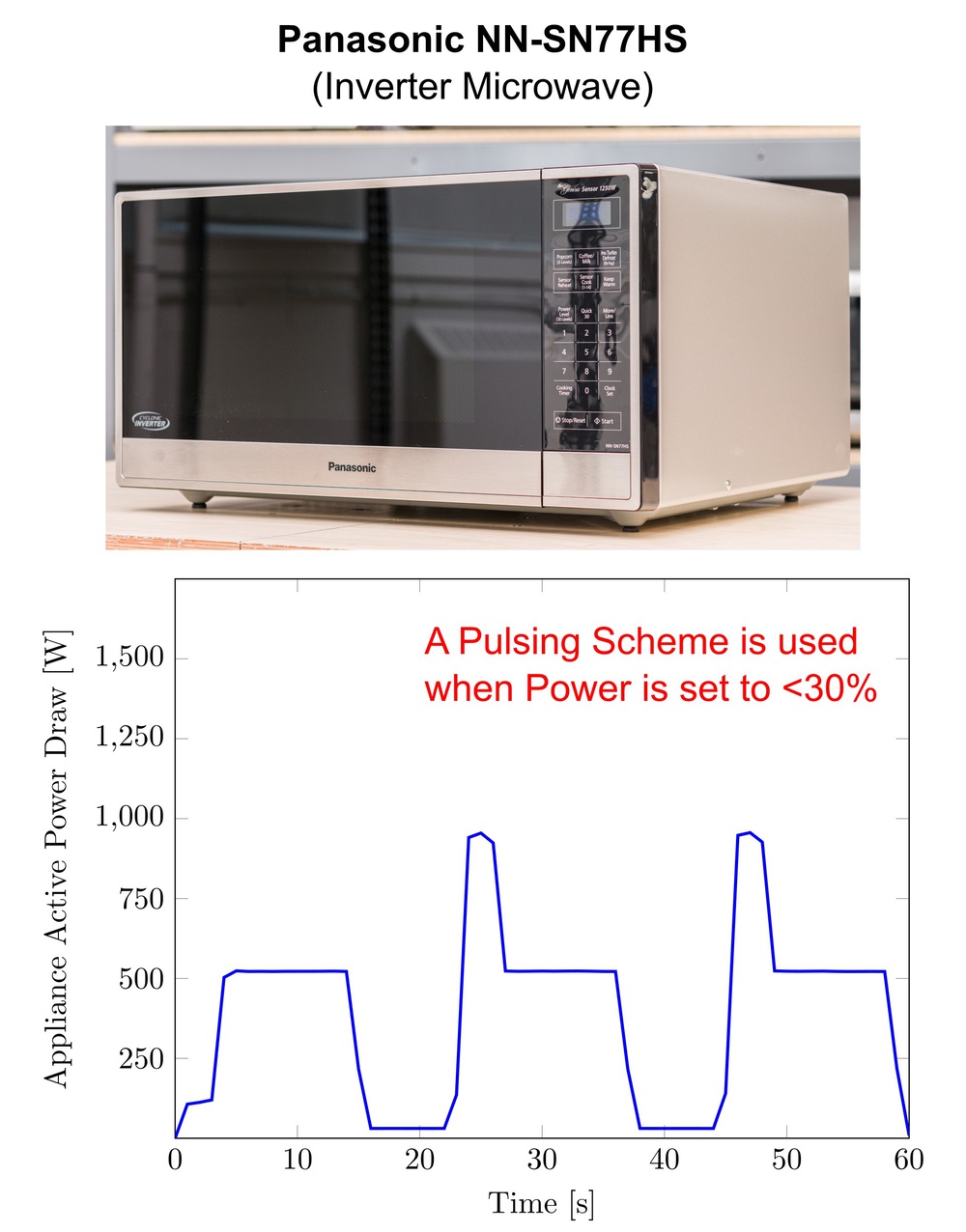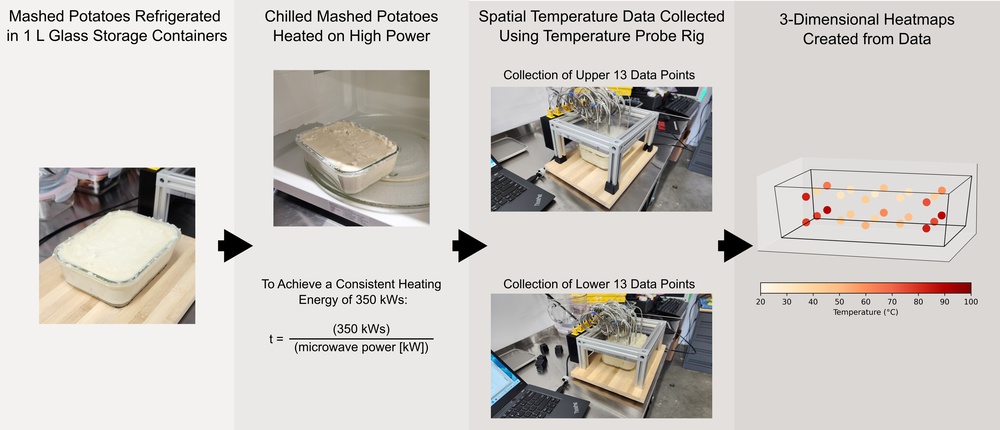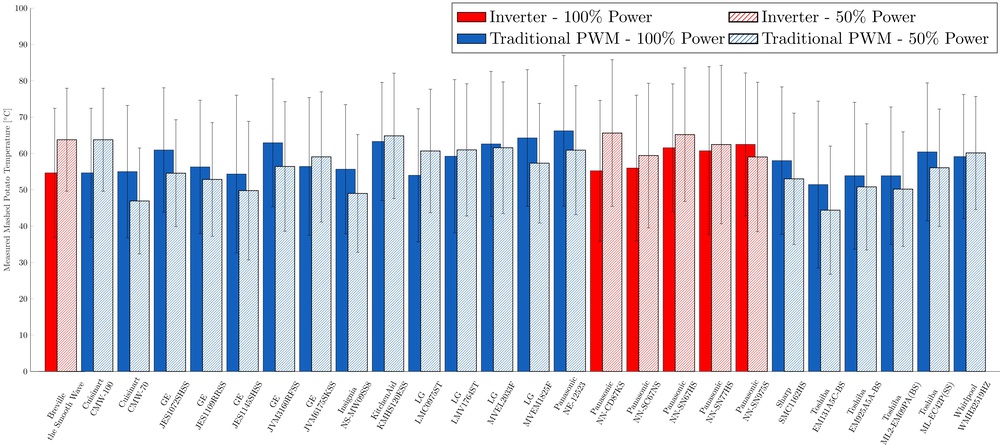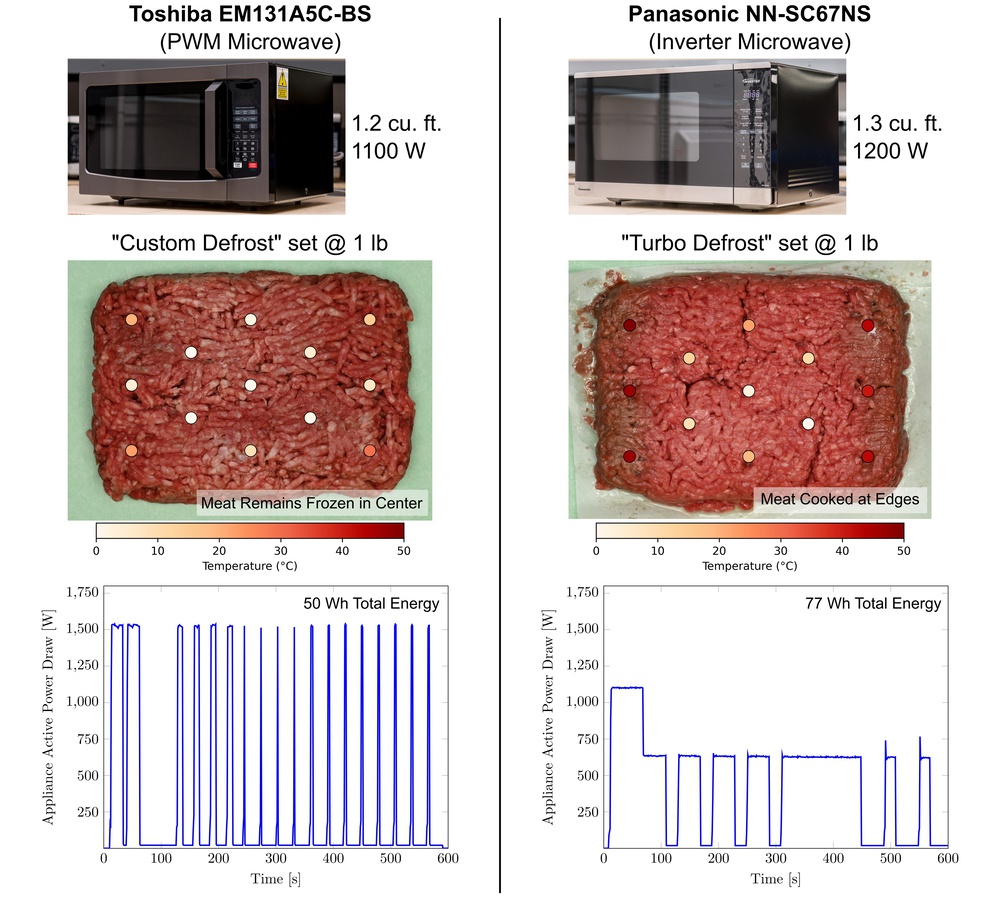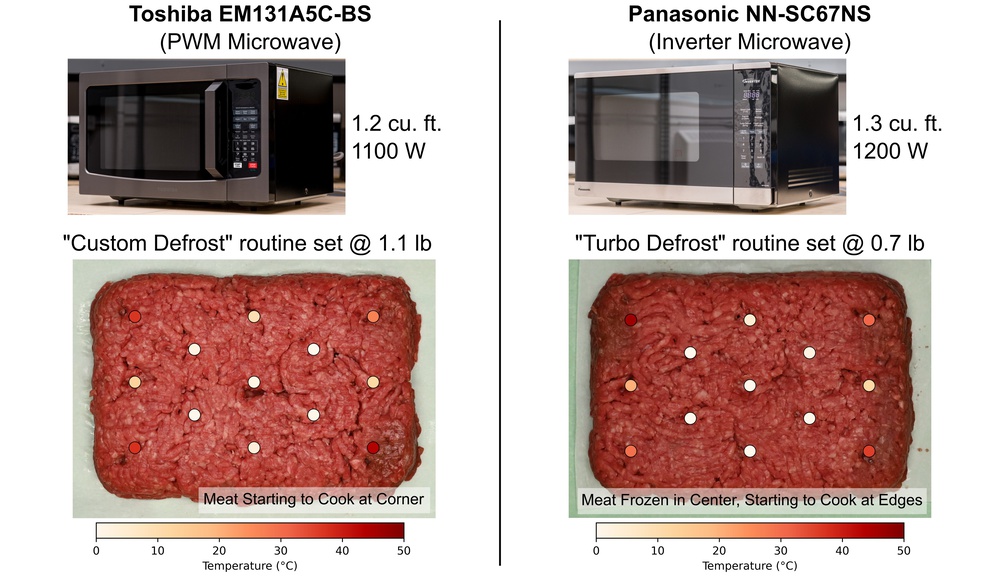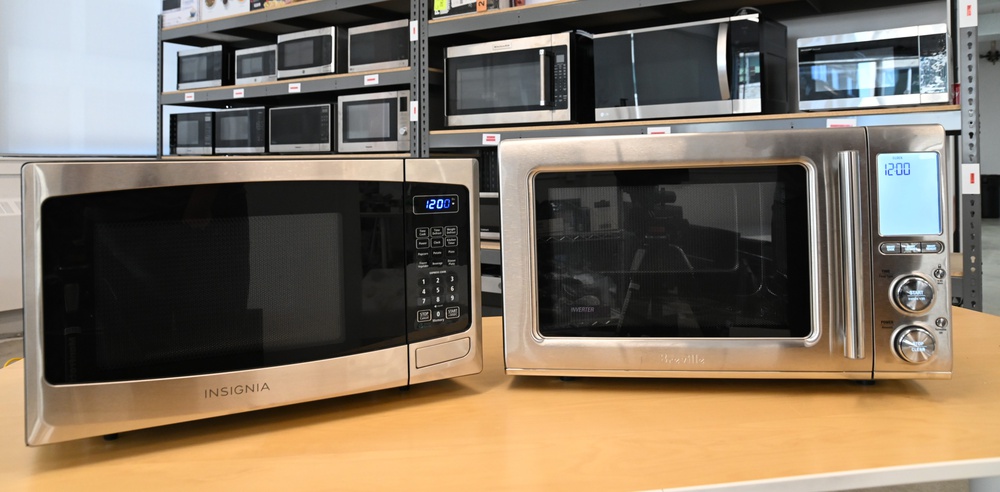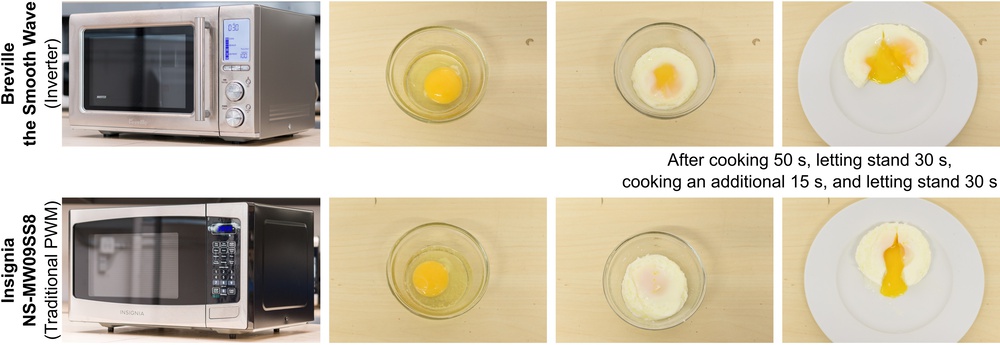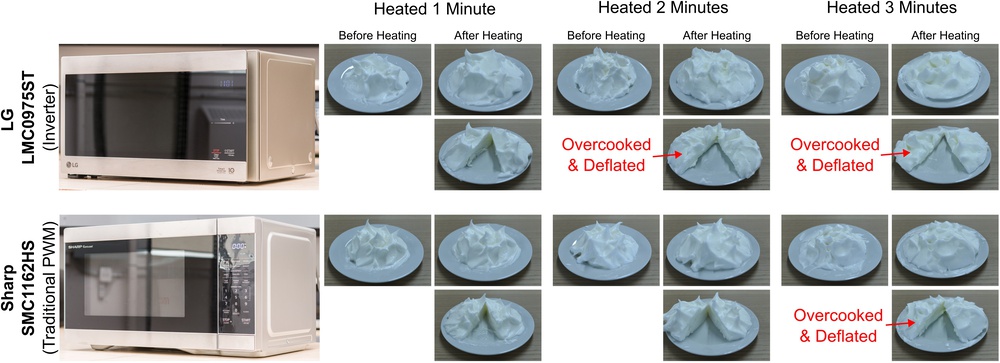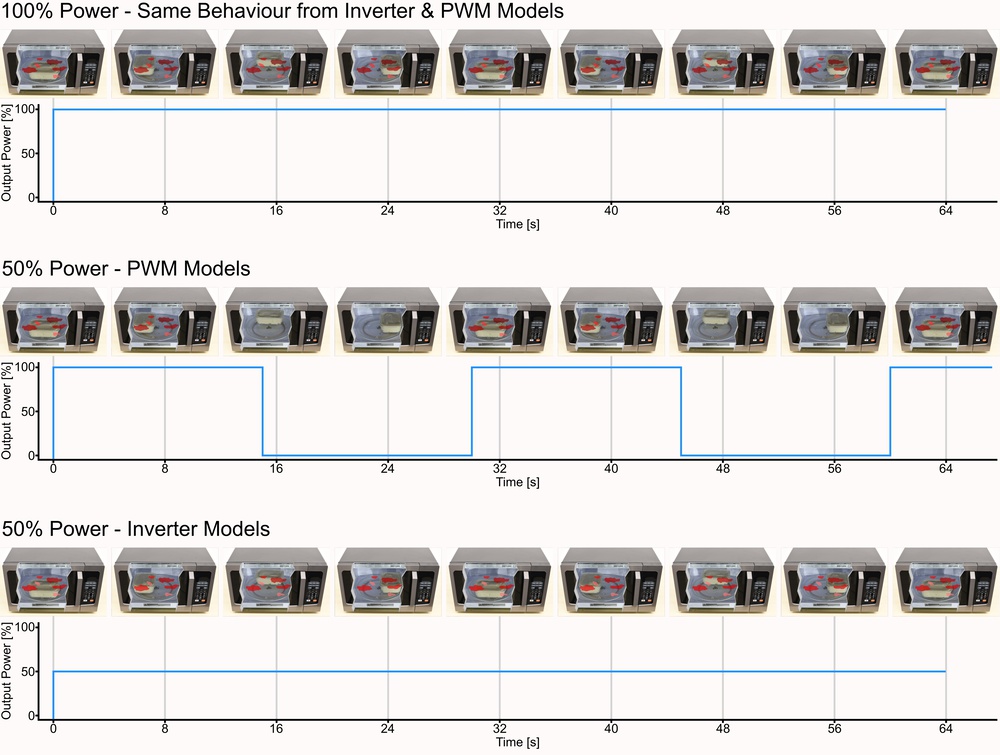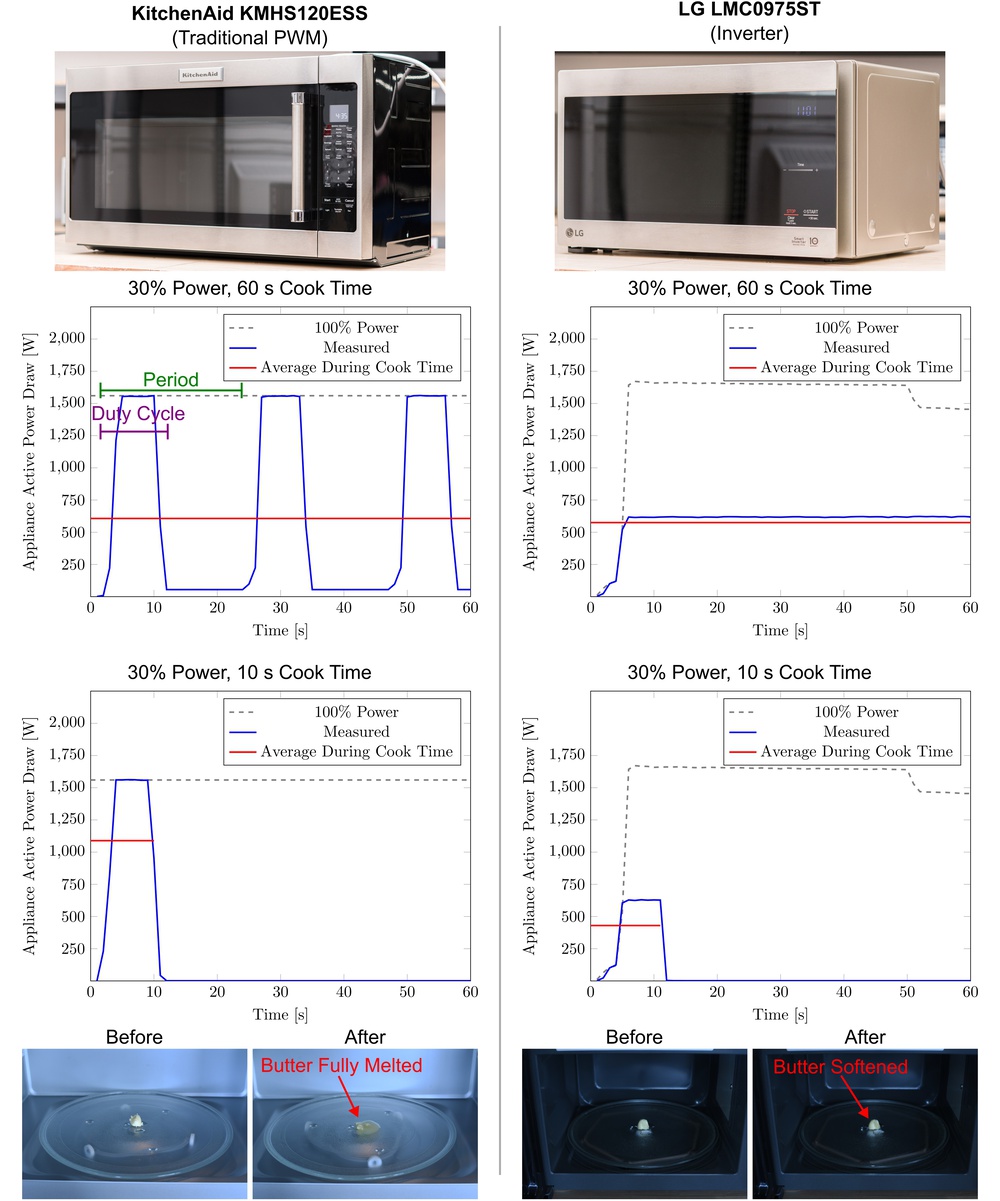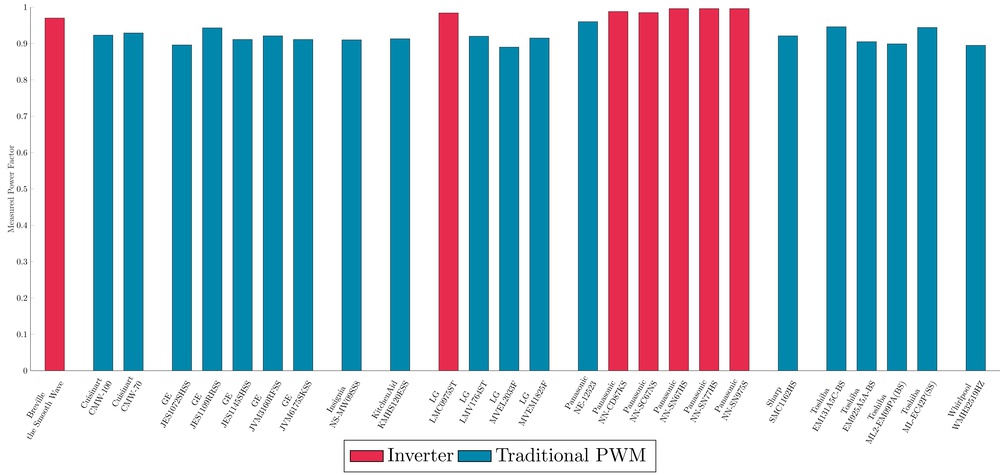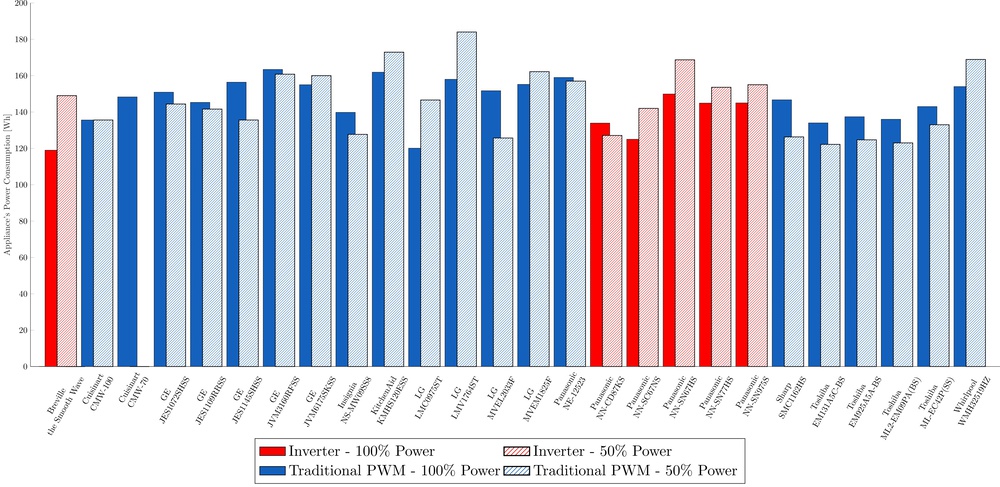- Many higher-end microwaves include an "inverter," which is marketed as offering more even heating, better results with delicate foods, and increased efficiency.
- Our extensive testing shows that inverters don't offer any real-world performance benefits due to the physics of heating with microwaves; they're only beneficial in extreme edge cases with very small amounts of food. They also won't save you any money on your electricity bill.
- Inverters are mainly a marketing tactic in a product category that otherwise lacks differentiation. You don't need to worry about your next microwave having this feature!
If you've been shopping for a new microwave, you may have seen the word "inverter" emblazoned on the front panel of many higher-end units. Manufacturers claim that an inverter microwave produces more evenly heated results, is more efficient, and is gentler with delicate foods. As part of our recently launched Microwave v1.0 Test Bench, we set out to find what exactly inverter technology is and if you should pay a premium for it. In short, our extensive testing has shown that although an inverter circuit is a real and distinct feature, its usefulness in this context is purely as a marketing tool in a product category that otherwise lacks significant differentiation.
Some of the marketing used by Breville, Panasonic, and LG to sell microwaves with inverter technology.
Our test bench was designed from the outset to highlight performance differences between the seven models we purchased with inverters and the 19 models we purchased without inverters. The "deep dish heating uniformity" tests were specifically included for this reason. However, as we discuss in an accompanying article, all the microwaves we tested have equivalent heating performance; the evenness in heating is controlled by the food and physics, not by the appliance.
A screenshot of the Table Tool for microwaves showing some of the design and performance tests that are part of Test Bench v1.0.
We did measure that inverter microwaves are slightly more efficient at the electrical circuit level, but you'll need to be an electrical engineer to appreciate it! The inverter models are marginally better at converting the total power they draw from an outlet (the apparent power) to useful work (the active power). However, your residential electricity bill is calculated based on active power use, so an inverter microwave won't save you any money.
We put in a lot of effort to test the claims that an inverter is necessary to effectively microwave "delicate" foods. We tried all the typical tasks manufacturers and users assert are sensitive to overheating by microwaves: cooking eggs, melting chocolate, softening butter, and defrosting meat. Ultimately, all microwaves can perform these tasks because of the physics of heating with microwaves. Regardless of the inclusion of an inverter circuit, a microwave oven only heats the outermost few centimeters of food, and each area is heated for short periods as the food is rotated relative to the standing wave.
We had to search very hard to find an exception where a microwave with an inverter performed a task that a non-inverter microwave couldn't! It turns out that inverter microwaves are better at tasks that require such little time that a non-inverter microwave can't effectively modulate power. The extreme example we found is the softening of 2 tsp of cold butter; an inverter microwave set to 30% power performs this task very well, while a non-inverter microwave yields melted butter.
We invite you to continue reading to learn more about microwaves and the testing we did to conclude that an inverter doesn't need to be a feature of your next microwave!
How Does a Microwave Oven Work? What Is an Inverter Microwave?
The microwave oven has become ubiquitous in kitchens across the world. And their basic design hasn't changed much since they were first introduced to consumers in the 1960s. As shown in the schematic on the left of the following figure, at its most basic, a traditional microwave consists of:
- Power Supply: TRIAC (switch), transformer, and rectifier, which provide high-voltage DC power
- Magnetron: vacuum tube that produces microwaves
- Cooking Chamber: metal box which reflects and contains the microwaves, leading to the formation of a stationary "standing wave"
- Turntable: moves food relative to the standing wave for more even heating
The basic components and operation of a traditional pulse-width modulated (PWM) microwave (left) and inverter microwave (right).
As food is exposed to the standing microwave within the cooking chamber, polar molecules (water, fat, sugar) align themselves to the electromagnetic field, and the friction of this movement creates heat. Energy (and, therefore, the ability to heat food) isn't evenly distributed within the three-dimensional space of the cooking chamber. This is because a wave has no energy at its nodes and max energy at anti-nodes.
The standing wave created in a traditional microwave is effectively only ever in one of two states: fully on or fully off. The power (i.e., energy over time) that's used to heat food is attenuated through "pulse width modulation" (PWM). In this control scheme, which is the basis of operation of all non-inverter microwaves (hereafter referred to as "PWM microwaves"), the circuit is pulsed on and off with a rather long period. It's interesting to note that the period of all our PWM microwaves is measured to be around 30 seconds and constant (i.e., it doesn't change with the input cook time). The percentage of each period in which the magnetron is powered and microwaves are being produced is known as the duty cycle.
As shown in the previous figure, an inverter microwave is like the traditional PWM microwave except for its upgraded power supply. The addition of MOSFET transistors in a high-frequency switching circuit allows for the generation of variable high-frequency AC power. This power is sent through a high-frequency transformer and rectifier to create high-voltage DC power which can be switched on and off very rapidly. The power supply and magnetron of an inverter model are indeed switched on and off as in pulse width modulation, but the period is so short that the generated standing microwave is effectively constantly on. The power of the standing wave is thus controlled by the duty cycle of the high-frequency inverter circuit.
Since Panasonic patented the inverter circuitry for microwaves, they and their licensees have marketed these appliances as being able to:
- More Evenly Heat Food: Always on microwaves of prescribed power
- Heat 'Delicate' Foods: Foods don't have to be exposed to 100% power like in a PWM microwave.
- Melting chocolate
- Cooking eggs
- Softening butter
- Defrosting meat
- Lower Power Consumption: Smaller, more efficient transformer
And indeed, these claims are often repeated by consumers in forums throughout the internet. However, we found it interesting that inverter microwaves also use pulsing of power in some circumstances. Namely, as shown in the following graph, we observed that an inverter microwave will cycle on and off when it's set to less than 30% power. We suspect this is because the magnetron can't operate at such low power inputs. We also noted that power pulsing features heavily in an inverter microwave's automatic defrosting routine; evidently, low steady power is insufficient for effective defrosting.
Screenshots of typical Reddit comments that promote the purported benefits of inverter microwaves over traditional PWM microwaves.
An Inverter Microwave Doesn't Yield More Evenly-Heated Food
From our description of how microwaves operate, it should be clear that, when set to 100% power, both PWM and inverter microwaves behave exactly alike. We, therefore, included the heating of food at lower power levels (chilled mashed potatoes at 50% power) in our test bench to elucidate any performance differences between the two types of microwaves. The theory/marketing behind including an inverter circuit in a microwave is that the constant, adjustable output of microwave power will result in more evenly heated food than the PWM power control mode.
The "deep dish" heating evenness test involved heating mashed potatoes chilled overnight in 1 L glass food storage containers. The containers of mashed potatoes were placed midway between the center and edge of the microwaves' turntables. We set the total microwave energy to heat the mashed potatoes at 350 kWs (so a lower-power microwave has a correspondingly longer cooking time, and the tests with 50% power took twice as long as the tests with 100% power in the same appliance). We then used an array of probes to measure the spatial temperature distribution at 26 points within the reheated mashed potatoes.
As shown in the following figure, our test results are remarkably similar when we control for total microwave energy. That is, an inverter circuit doesn't allow a microwave to produce mashed potatoes that are either more efficiently heated (i.e., with a higher mean temperature) or more evenly heated (i.e., with a smaller standard deviation in temperatures).
An Inverter Microwave Isn't Necessary to Heat Delicate Foods
After observing that inverter microwaves were no better at producing evenly heated food than traditional PWM microwaves, we moved on to the claim that they're better at heating 'delicate' foods. The theory/marketing is that traditional PWM microwaves will subject foods to 100% power during the duty cycles, and this 100% power will lead to overheating of the food in some areas, which inverter microwaves won't. The typical tasks quoted as being 'delicate' include:
- Defrosting Meat
- Softening Butter
- Melting Chocolate
- Cooking Eggs
We tested all these cases to see if inverter microwaves were indeed necessary to achieve good results.
Having an Inverter doesn't Guarantee the Microwave is Great at Defrosting Meat
We began with a test of the defrosting performance of two comparable microwaves: the Toshiba EM131A5C-BS (PWM, 1.2 cu. ft., 1100 W) and the Panasonic NN-SC67NS (Inverter, 1.3 cu. ft., 1200 W). We froze 1 lb portions of medium ground chuck and used the microwaves' automatic, weight-based, pre-programmed routines to defrost the meat. The frozen meat was placed approximately midway between the center and edge of the microwaves' turntables. We also followed the directions in both user guides to flip the meat halfway through the process.
As shown in the following figure, inputting a weight of 1 lb for the automatic defrosting routines didn't yield perfect results in either microwave. The Toshiba didn't fully defrost the meat (even after 10 minutes of standing following the routine, as suggested in its user guide). And the Panasonic fully cooked the edges of the meat.
The defrosting performance of a popular PWM microwave and inverter microwave. Temperature probe data is superimposed over the photographs of the resulting meat. Both microwaves pulse the energy on and off according to specific pre-programmed routines.
We measured the appliances' power draws to deduce why the two models produced such different results. It's telling that the Panasonic with an inverter uses pulsing of the microwaves in its defrosting routine; evidently, the manufacturer has found that attenuation of the standing wave power through the inverter circuit alone is insufficient to effectively defrost without cooking. Furthermore, the Toshiba model's use of very narrow pulses of 100% power appears to be more effective at avoiding cooking the beef while it defrosts. Calculating the total energy draw of the appliances for their respective routines (i.e., the area under their power-vs-time curves) reveals that the Panasonic microwave's routine outputs 50% more total energy than the Toshiba model.
We finally attempted to get better defrosting results from both the Toshiba EM131A5C-BS and Panasonic NN-SC67NS by adjusting the weight input into their pre-programmed routines. As shown in the following figure, increasing the weight input into the Toshiba to 1.1 lb yielded fully defrosted meat that was just beginning to cook in one corner. On the other hand, decreasing the weight input into the Panasonic all the way to 0.7 lb still produced meat that was starting to cook at the edges while the meat remained frozen in the center (even after 10 minutes of standing time).
Even with an adjustment to the meat's input weight, the inverter microwave couldn't fully defrost without cooking the edges.
In all, these observations reveal that effective defrosting without cooking is more about the design of the routine rather than the inclusion of an inverter circuit in the appliance. The reason is that there's a positive feedback loop involved when trying to heat frozen food in a microwave oven. When frozen, water molecules can't vibrate under the electromagnetic field of the standing microwave and, therefore, won't produce any heat from friction. You can try this at home by heating ice in your microwave: it won't melt! The corollary to this is that only areas of food that are already defrosted will be heated, and the only way to heat frozen areas is through conduction. In sum, it's very easy to overheat/cook some areas of food that you're attempting to defrost in a microwave, and very short pulses of energy are an effective way to avoid that.
Even the Cheapest Microwave can Heat 'Delicate' Foods
We investigated the microwaving of other foods that are often claimed to be "delicate"—and, therefore, require an inverter microwave—by choosing two extreme appliances from our cohort. On the one end, there's the Insignia NS-MW09SS8, a traditional PWM microwave and the least expensive model we tested at $90. At the other end of the spectrum is the Breville the Smooth Wave, an inverter microwave priced at $400.
We tested the inexpensive Insignia NS-MW09SS8 (traditional PWM microwave) and high-end Breville the Smooth Wave (inverter microwave) for their ability to heat delicate foods.
The first test we performed was softening a stick of refrigerated butter. Here, an overshoot in heating would result in melting (and you can't use melted butter in a recipe that calls for softened butter). We first tested a method where a stick of butter is microwaved at 30% power in 5-second segments, with the stick rotated 90 degrees (with a different face touching the plate) between segments. The plate was placed approximately midway between the center and edge of the turntables. You can see the results of this microwaving in the following videos. Here, both microwaves have produced nicely softened butter.
Interestingly, the 5-second cooking time of each heating segment is shorter than the Insignia's duty cycle at 30% power. The average microwave power the butter stick is subjected to is 100%, not 30%! This is why the Insignia only required four 5-second heating segments while the Breville required eight. It also makes clear that an inverter isn't necessary for this task.
| Insignia NS-MW09SS8 (Traditional PWM) | Breville the Smooth Wave (Inverter) |
|---|---|
Nonetheless, we wondered if having an inverter would make the overall task of softening butter "easier." So, we performed the test again, but this time, we heated the butter sticks in one single segment. The resulting butter sticks are shown in the following videos. Again, both microwaves yielded remarkably similar results. We'll note, however, that the butter made in a single segment is much less evenly softened. Rotating the butter every 5 seconds allows all areas of its surface to be exposed to the different areas of the standing microwave. Perhaps more importantly, opening the microwave door, rotating the butter, closing the door, and restarting the microwave gives time for the conduction of heat to occur from the surface to the interior of the butter. In sum, an inverter microwave doesn't make the task of softening butter easier, more hands-off, or more foolproof.
| Insignia NS-MW09SS8 (Traditional PWM) | Breville the Smooth Wave (Inverter) |
|---|---|
We next tested these microwaves' ability to melt 8 oz of semi-sweet chocolate. We followed the technique from Southern Living, wherein a bowl of chopped chocolate is heated at 30% power in 30-second segments, stirring between segments. The glass bowl was placed approximately midway between the center and edge of the microwaves' turntables. As can be seen in the following photos, both the Insignia and Panasonic microwaves performed this task equally well. The chocolate turns out nice and smooth, with no "seizing" (overheating, leading to graininess and clumping) in either case. Here again, we observe that the short timescales of full power involved when using a traditional PWM microwave at low power settings pose no real problem to the food being heated. Furthermore, based on our work with meat defrosting and butter softening, we don't expect that the inverter microwave could make this task any "easier" by offering a hands-off experience.
Chocolate can be melted just as well in a microwave without an inverter. Setting the power to 30% and stirring throughout the process yields melted chocolate without seizing.
And finally, we tested the ability of the Insignia and Panasonic microwaves to cook eggs. Our first task was cooking an "over easy" egg by following a recipe by The Egg Farmers of Canada. The eggs were cooked in an oiled ramekin—placed approximately midway between the center and edge of the turntables—at 50% power for 50 seconds, allowed to stand for 30 seconds, cooked for an additional 15 seconds, then allowed to stand for a final 30 seconds. The following photos demonstrate the great results we achieved with both microwaves, with fully cooked whites and runny yolks. A taste test of the eggs confirmed that neither the PWM nor inverter method of power control resulted in overcooked/rubbery eggs.
"Over easy" eggs can be cooked in a microwave without an inverter just as well as one with an inverter.
The second egg cooking task we performed was the preparation of "scrambled eggs," again using a recipe from The Egg Farmers of Canada. In this method, two eggs are whisked with milk, salt, and pepper in an oiled bowl. The glass bowl was placed midway between the edge and center of the microwaves' turntables and heated at 70% power in 20-second segments, with stirring between segments. As seen in the following figure, curds start forming in the eggs after three rounds of heating and stirring. After five rounds, the eggs are just about cooked to the desired texture. After an additional 15 seconds, followed by 1 minute of standing, the eggs are cooked to our liking. The photos and a taste test revealed that both the Insignia and Breville microwaves produced identical scrambled eggs without any overcooking. And while they may not be what you would get at a French restaurant, we recommend this method for scrambled eggs in a pinch!
Even scrambled eggs can be cooked in a microwave without an inverter just as well as one with an inverter.
The final egg task we attempted was the cooking of whipped egg whites. Here, we tried to work with an extreme example—a "delicate" food with a lot of surface area and protrusions with a small volume that we would cook in a single shot. We also switched up the appliances for two other comparable microwaves: the LG LMC0975ST (0.9 cu. ft., 1000 W inverter microwave) and the Sharp SMC1162HS (1.1 cu. ft., 1000W traditional PWM microwave). The plates of whipped egg whites were placed approximately midway between the center and edge of the microwaves' turntables. The figure below presents the results from heating the whipped egg whites with 30% power for 1, 2, and 3 minutes. It was surprising to observe that the LG inverter microwave began to overcook the egg whites (odd texture and deflated) with 2 minutes of heating, while the Sharp traditional PWM microwave didn't overcook the egg whites until 3 minutes of heating. In sum, an inverter doesn't make microwaving eggs any easier or produce better results.
What Is an Inverter Microwave Better At?
In the end, our testing has shown that both types of microwave power control result in food that's heated in a remarkably similar way. The reason for this comes down to the physics of how food is heated by microwave ovens:
- There's an uneven energy distribution: The standing microwave created in the cooking chamber has high energy and low/no energy areas.
- Food moves relative to standing wave: A turntable is used to move food in and out of the high energy. Each area of food goes through cycles of localized heating and resting. This is true of both inverter and PWM power control and is shown in the following schematic.
- Microwaves only penetrate 1 – 3 cm of food: Depending on the composition of the food, only the polar molecules in the outermost few centimeters vibrate and heat up.
- Conduction into the food's bulk is slow: While areas of the food aren't exposed to the high energy of the standing wave, localized heat from its surface transfers via conduction to the interior. This process is much slower than the dielectric heating via microwaves.
A schematic of how food is moved relative to the stationary standing microwave. Here, the period of the PWM is 30 seconds, and the turntable makes one rotation every 32 seconds. Regardless of power control type, each area of food is subjected to the standing wave for only a short period.
Ultimately, the two different timescales dictate that all microwaves have similar heating performance regardless of the power control scheme. On the one hand, there's a short time in which each area of the food is within high-energy portions of the standing microwave and is being heated (at the food surface) per cycle. We have measured the turntable rotation speed of our microwaves to be just under 2 RPM. So, the exposure time is on the order of a few seconds (per cycle). On the other hand, it takes a relatively long time for heat to be conducted from high-temperature areas at the surface to low-temperature areas in the bulk. The speed of this heat transfer depends on the properties of the food itself (e.g., thickness, viscosity, thermal conductivity) but is on the order of minutes. Note that the standing time of 10 minutes suggested in the user manuals for meat defrosting and 1 minute suggested in the recipe for cooking eggs follows naturally from the timescale of heat conduction in food.
As the timescales are so different, the cycling of heating the food surface discontinuously with microwaves and then conducting this heat into the bulk evidently works just as well whether the standing wave is energized continuously (as in inverter) or in pulses (PWM). In sum, conduction is the controlling phenomenon here.
However, the equal heating performance of inverter and traditional PWM microwaves would break down if the timescales of dielectric microwave heating of the surface and conduction into the bulk became equivalent. This would occur if the food didn't move relative to the standing wave (i.e., it was placed in the center of the turntable) and had a very small volume (i.e., it took very little time to conduct heat to its bulk). The equal performance would further break down if both the microwaves weren't subjecting the food to the same average energy.
The following figure compares a traditional PWM microwave, the KitchenAid KMHS120ESS, and an inverter microwave, the LG LMC0975ST. At sufficiently long cook times, the time-averaged power draw is essentially equivalent for both microwaves. However, when the cooking time is less than the constant period of the PWM, the average power during the cooking time is dramatically higher than expected. An extreme case would be a cook time that's equal to or less than the duty cycle of the set power (~10 seconds for 30% power). For such short cook times, an inverter microwave will indeed give more accurate cooking power (i.e., an average power more closely matching the setting).
The period of a traditional microwave's PWM doesn't change with the set cook time. When the cooking time is less than this period, especially when it's less than the duty cycle, the average power is much higher than expected. An extremely delicate task, like softening a tiny amount of butter, can't be easily done in a PWM microwave; an inverter microwave accomplishes this task without issue.
We combined all these concepts to present an extreme example where an inverter microwave performs a function better than a traditional PWM microwave. This edge case is the softening—without melting—of 2 tsp of refrigerated butter. This is such a small amount of butter that softening requires a cook time approaching the duty cycle of a PWM microwave set to 30% (i.e., the lowest power setting that an inverter microwave can steadily run at). As shown in the previous figure, a ball of refrigerated butter placed in the center of the PWM microwave's turntable melts within 10 seconds of cooking time. More average microwave power is being used than expected, the butter is stationary with respect to the standing wave, and conduction into the bulk of the small volume of butter is quick. Contrarily, the same amount of refrigerated butter is effectively softened in an inverter microwave because much less average microwave power is used.
Edge case tasks, like softening a couple of teaspoons of butter, might be important to a minority of users. For those select individuals, we recommend purchasing an inverter microwave. For everyone else, we don't believe the increased purchase price is justified.
In Fairness, an Inverter Model Is Slightly More Electrically Efficient
While our testing has shown that inverter microwaves offer no real-world performance benefits over their traditional PWM counterparts, we should acknowledge that the claims of inverter microwaves being more efficient are true. Inverter circuits use efficient MOSFET semiconductors for their switching. And because an inverter circuit uses a smaller, high-frequency transformer, there are fewer losses to heat and the establishment of electric and magnetic fields.
The electrical efficiency of an appliance can be described by the "power factor" which is measured using an appropriate logging power meter. The power factor is the ratio of the "active" (or "real") power to the "apparent" power. The active power is the power consumed by the appliance to perform useful work, measured in Watts; the apparent power is the total power drawn from the source (i.e., the electrical outlet), measured in Volt-Amperes.
Indeed, as shown in the following graph, we measured the microwave ovens with inverter circuits to have higher power factors than the traditional PWM microwave ovens.
Measured power factors for the 26 units tested as part of the launch of the Microwave test bench. Models with an inverter have the highest power factors and are, therefore, more efficient at the electrical level.
However, this increased electrical efficiency may be a moot point. Residential electricity users are typically charged based on the active power they consume (i.e., kWh of electricity). And, as shown in the following figure, when we measured all our microwaves while heating the mashed potatoes for the deep-dish heating evenness test, the models with inverters didn't have any noticeably lower active power consumptions.
Measured active power consumption for the 26 units tested while reheating mashed potatoes with 350 kWs of microwave energy. The models with an inverter don't consume less active (and therefore billed) power.
Don't buy an inverter microwave expecting it to save you money on your electricity bill!
Conclusion
Our extensive testing and analysis show that inverter microwaves offer some advantages in very specific situations but aren't essential for most everyday cooking tasks. Our results show that inverter microwaves don't produce more evenly heated food than traditional PWM microwaves. Both types also perform equally well in delicate heating tasks such as melting chocolate, cooking eggs, and defrosting meat, provided they have well-designed routines. We also didn't measure decreased power consumption in models with inverters compared to models without.
Consumers shouldn't feel obligated to pay extra for an inverter microwave, as traditional models can efficiently and effectively handle all typical microwave tasks. In reality, the best use of an inverter in a microwave seems to be as a marketing tool, enabling manufacturers to differentiate their models in a product category that otherwise lacks significant differentiation.

